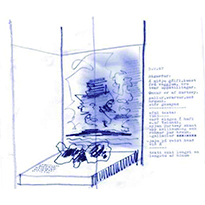Was Skarphéðinn Jóhannsson a radical architect?
If so, in what sense?
Abstract
There is no doubt that architecture affects people’s lives. It shapes our movement along the day, frames our visions and relationship between inside – outside. It provides spaces for activities, needs, and leisure. When Skarphéðinn Jóhannnsson was born 1914 in Iceland, the country was based on agrarian principals and with no real city formation. On a smaller scale, a bedroom was not even considered necessary in housing. During his childhood, toilets were scare or non-existing and livestock was common in the village of Reykjavík.
Skarphéðinn opened his office in Reykjavík in 1952, aged 38 years, then an ebonist and architect from Copenhagen, the Kunsthåndværkerskolen (1935-1938) and Kunstakademiets Arkitektskole (1945-1949). He had also worked in Kaare Klint‘s architecture office in Copenhaguen (1950) and spent a year on a Grand Tour in Italy (1951). With such a background, it will be reflected on whether Skarphéðinn‘s proposals can be considered radical in Iceland or revolutionary? Or was he, together with fellow architects, modernising the country and feeling a need elevate the society?
In the Icelandic context, it will be argued that Skarphéðinn surely created typologies responding in radical ways to new demands for a modern society based on relative values.
Downloads

Downloads
Published
How to Cite
Issue
Section
License
Copyright (c) 2024 Halldóra Arnardóttir

This work is licensed under a Creative Commons Attribution 4.0 International License.
The authors keep their rights upon their work, although they transfer, in a non-exclusive way, the rights of exploitation (reproduction, publication, distribution, public dissemination and presentation) to the Journal. The authors are, therefore, free to enter additional, separate contracts for the non-exclusive distribution of the version of the work published in the Journal (for instance, by hosting in an institutional repository or publication in a book), provided credit is given that the work was initially published in this journal. The works are published under a Creative Commons Attribution 4.0 (CC BY 4.0) license.











